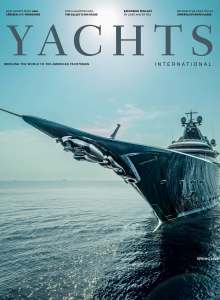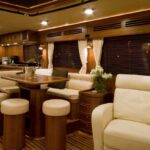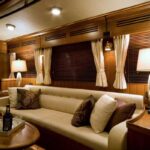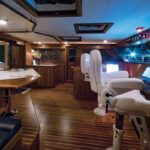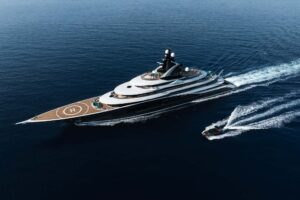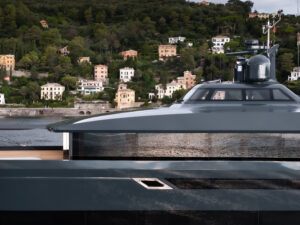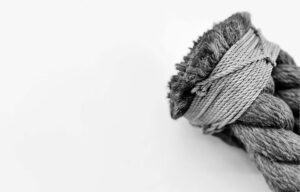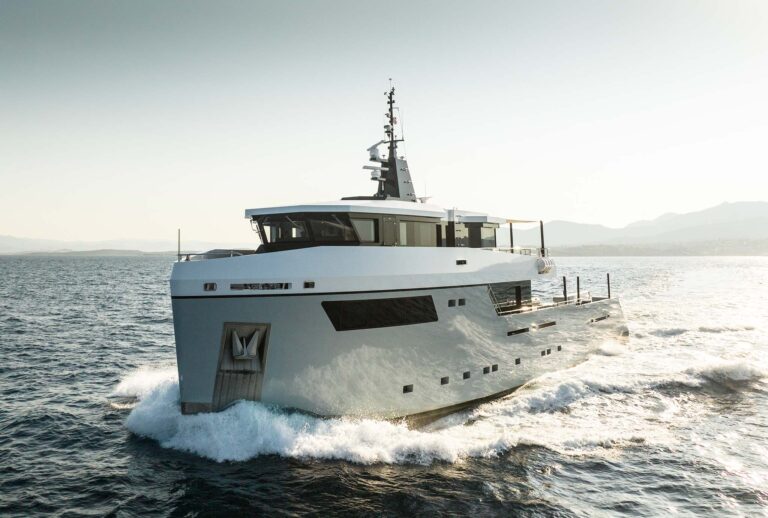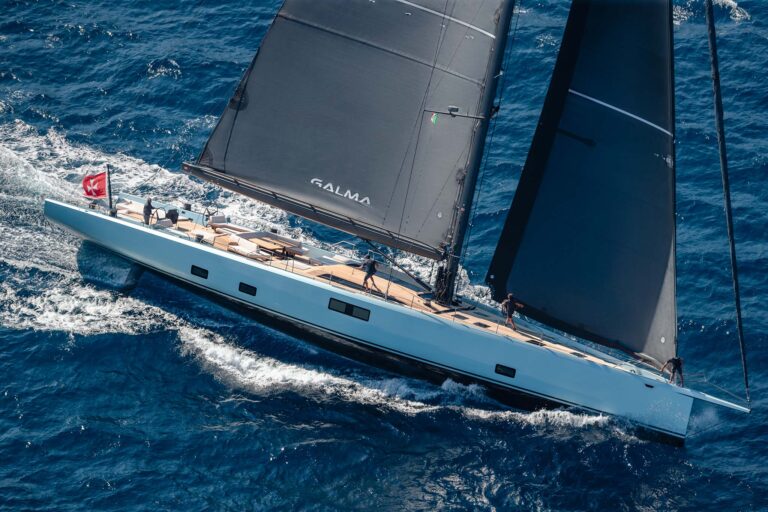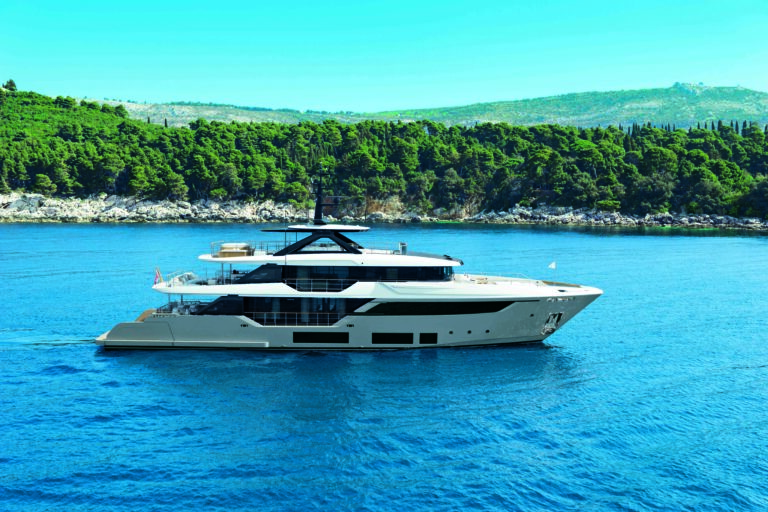David Marlow was certain he had the right idea when he launched his first Voyager. Wanting to demonstrate that his alternative to the conventional explorer genre—a light and low-profile composite boat designed to “dance with the waves”—was indeed a valid contender, he invited other builders to an endurance trial. There were no takers. No takers, that is, until a couple of experienced sailors from Australia decided to put his Marlow Voyager 76LR to the ultimate test.
Photos Scott Pearson

Vicki and Maynard Smith started sailing when they were in their 30s. They had their previous boat for 13 years and sailed 50,000 miles with her. They did not think they would sell it until a friend planted a seed in 2010. Slowly but surely they started looking around; they read emails, listened to suggestions and flipped through pages of magazines. Someone brought up a Marlow 65; that boat did not have the range they wanted, but the Marlow 76LR Maynard read about looked like it might.
Vicki, who writes the couple’s online blog, says Maynard loves to read about what’s new and innovative. Something about Marlow’s fresh approach to the long-range explorer must have struck a chord. Their choice may also have had to do with David Marlow’s fondness for sailboats and offshore sailing competition.
Indeed, it was sailboats and their rapid evolution in shape and speed that inspired Marlow. He noted that by giving up on accepted ideas, sailboat builders improved speeds from 6 to 8 knots to well over 20 knots, or more. “That was accomplished by giving up the old idea that boats have to be constrained by their shapes,” he told us during an interview in February 2010. “The same thing was possible in power yachts if we started with a clean sheet of paper and a fresh mind.” That’s the approach Marlow took with the Voyager 76.
The Voyager’s hull is resin-infused using Marlow Norsemen’s proprietary Full Stack Infusion. “We build our boats very much like a military aircraft. … In an airplane, you don’t see bulkheads all over the place,” he said. “The skin is the frame, and that is very much how we build a Marlow,” he added.
This technique allows Marlow to make a lighter boat with good volume and a generous 7-foot-8-inch headroom. In a modest LOA of 78 feet, the Voyager has five cabins, including an ondeck master with ensuite bathroom, a large salon with full galley and dining area, crew cabins and plenty of storage. Yet, its overall height is only 18 feet, 6 inches. While the engines and propulsion are fairly conventional, the hull’s stern area is shaped like an F-15 military airplane with twin tails that act as feathers on an arrow. A pair of foils, called strut keels, help reduce drag. Together they’re meant to help the boat maintain direction while increasing performance and speed. The yacht was also equipped with solar panels to supplement the twin generators.
In the end, the boat simply met the Smith’s requirements. “Overall, we needed a vessel to transport us safely to exotic places with a high margin of safety but we also wanted a vessel which was fun to operate and pleasing to the eye.” Still, the Voyager 76 was a big step, with not only more space to enjoy long passages but many more systems that require attention and maintenance. And because Maynard still runs a business and cannot be on deck at all times, these fiercely independent globetrotting vegetarians would have to have a crew. They fretted about all of it for a while. Nevertheless, they became fairly sure this boat could replace their cherished 52-foot Santa Cruz Cruz Control.

Maynard formulated a plan and put it to Vicki as they sipped tea on their back porch in Australia. “How ’bout we try to buy that Marlow in Florida, leave in October for the Caribbean, then go to Patagonia, have a photo taken off Cape Horn, then go across the Pacific and bring it back home to Australia?” A bit incredulous at first, Vicki quickly came around. “Hmmm. That sounds like an exciting idea. We should do that!” Vicki recalls saying, as she gave up on plans of renovating their 1978 farmhouse.
They bought the boat from David and Barbara Marlow and christened her Vanish. They got their cruising permit in October 2011 and worked remotely with the yard on final outfitting. The couple arrived at Marlow Yachts’ facility on Florida’s west coast on May 15, 2012. It took a few more weeks to get the boat just as they wanted it and check out all the systems. Through it all, the Marlow Yachts team was supportive. They lifted anchor, with a full load of spare parts, on June 20. The couple came close to three tropical storms in three weeks but rounded Cape Hatteras on June 25.
They’ve documented their journey meticulously, from the hiring of the crew, the ports they visited, the storms they avoided, to the plans that lie ahead. Except for an encounter with four armed steel-toe-boot-clad coast guard officers who boarded their vessel near the United Nations on the East River in New York in a boisterous 4- to 5-knot current—an adventure that they took in stride—their experience of traveling in North America has been a good one. The couple has enjoyed the comfort their new yacht has provided them during the 3,500-mile journey they’ve taken to date from Florida to Nova Scotia to South Carolina.
“Our former yacht had essentially one deck, a beam of 14 feet and maybe 35 feet of living space in the overall 52-foot length. Vanish, on the other hand, is over 20 feet wide over much of its 76-foot length with three decks, all with spacious cabins and filled with all sorts of technology and wonderful timesaving and safety devices. Her large size gives us a great deal more comfort at sea; comfort, quite frankly, we’ve never experienced before, making passages something we both look forward to,” write Vicki and Maynard in their blog titled “Making the Switch from Sail to Power.”

Their experience has given them information that will be valuable for the most ambitious part of their journey—an approximately 3,100-mile crossing from South America to Tahiti in French Polynesia. On their longest leg to date, about 856 miles from the Florida Keys to Virginia, they averaged 9.5 knots and consumed 1,100 gallons of fuel, excluding generators. They also determined that at 8 knots and with a three-quarter load, their engines burn about 8 gallons an hour. “We will be very careful with genset usage and would expect to arrive in Tahiti with approximately 800 gallons in reserves,” they told the Marlow team that eagerly follows their progress.
As it turns out, the builder is not the only one who has taken interest in Vanish’s extraordinary journey. “We have quite a large following of family, friends and strangers as people seem fascinated with Vanish and our exploits,” Vicki wrote me a couple of weeks ago. Their adventure continues on sailblogs.com/member/vanish/
For more information visit marlowyachts.com
LOA: 82ft. 7in. (25.14m)
LWL: 76ft. 6in. (23.17m)
Beam (max.): 20ft. 9in. (6.32m)
Draft: 5ft. (1.52m)
Displacement: approx. 115,000lb (52,163kg)
Material: composite/sandwich
Fuel capacity: 4,500 gal (17,029L)
Water capacity: 400 gal. (1,513L)
Watermaker: 60 gal. (227L) Sea Recovery
Engines: 2 x CAT C18 @ 1,015 hp each
Generators: 2 x 26 kVA Onan Generators
Propellers: 4-bladed 40in. propellers with 37in. pitch*
Solar panel: 1,800 kW
Speed (max.): 24 knots light ship/16 knots loaded
Stabilizers: Naiad
Naval architecture: Marlow Yachts
Builder: Marlow Norsemen
Year: 2010


